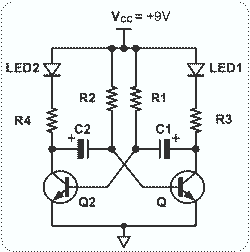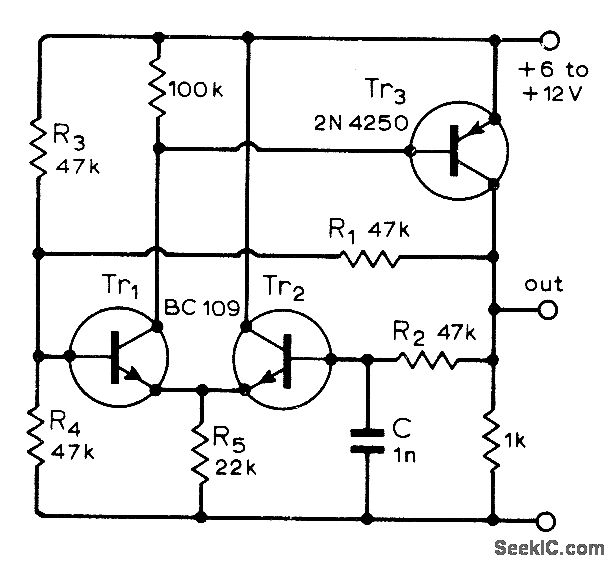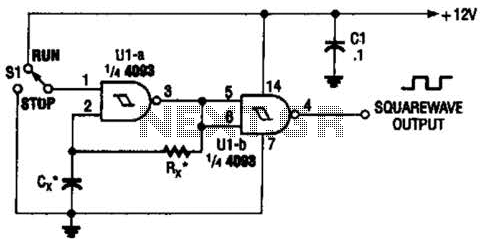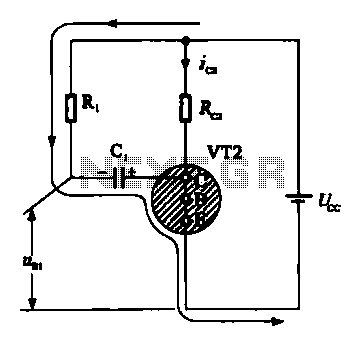
Astable Multivibrator
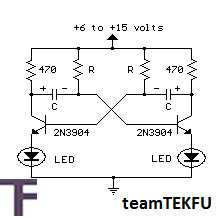
This circuit is an astable multivibrator designed to alternately flash two LEDs. The resistor (R) and capacitor (C) values determine the frequency of the flashing, while the 470-ohm collector load resistors limit the current to approximately 20 milliamps when the circuit operates at 12 volts. The frequency is approximately one cycle per second, utilizing 22 microfarad capacitors and 47-kilohm resistors. Smaller resistor and capacitor values will increase the frequency. The LEDs can also be connected in series with the collector resistors, and alternative transistors may be employed.
The astable multivibrator circuit is a fundamental application of bipolar junction transistors (BJTs) configured to produce a continuous square wave output. This circuit does not have a stable state; instead, it oscillates between two unstable states, which results in the alternation of LED illumination.
In this configuration, two NPN transistors are used, each connected to a resistor-capacitor (RC) timing network. The timing network consists of two resistors and two capacitors, with each transistor controlling one LED. The charging and discharging cycle of the capacitors through the resistors determines the oscillation frequency. When one transistor turns on, it allows current to flow through its associated LED, causing it to light up, while simultaneously turning off the other transistor and extinguishing its LED.
The choice of a 470-ohm collector load resistor is crucial as it sets the maximum current flowing through the LEDs, ensuring they operate within safe limits without being damaged. The 20-milliamp current is suitable for standard 5mm LEDs, providing adequate brightness without overheating.
The frequency of oscillation can be adjusted by varying the values of the resistors and capacitors in the circuit. Using smaller resistor values or capacitors will result in a higher frequency, allowing for more rapid alternation between the two LEDs. This feature enables customization of the flashing rate to suit specific application requirements.
For applications requiring different brightness levels or color combinations, various types of LEDs can be used, and they can be wired in series with the collector resistors. Additionally, different transistor types can be selected based on the desired switching speed and current handling capabilities, which can further enhance the circuit's performance. This flexibility makes the astable multivibrator circuit a versatile choice for LED flashing applications in various electronic projects.This is an Astable Multivibrator Circuit to alternately flash two LEDs. The R and C Values determine the frequency and the 470 ohm collector load resistors set the current to about 20 miliamp, when the circuit is operated at 12Volts. Frequncy is about 1Cylce per second using 22uF capacitors and 47K resistors. Smaller R and C Values will increace Freq uency. The LEDs may also be wired in series with the collector resistors and other transistors can be used. 🔗 External reference
The astable multivibrator circuit is a fundamental application of bipolar junction transistors (BJTs) configured to produce a continuous square wave output. This circuit does not have a stable state; instead, it oscillates between two unstable states, which results in the alternation of LED illumination.
In this configuration, two NPN transistors are used, each connected to a resistor-capacitor (RC) timing network. The timing network consists of two resistors and two capacitors, with each transistor controlling one LED. The charging and discharging cycle of the capacitors through the resistors determines the oscillation frequency. When one transistor turns on, it allows current to flow through its associated LED, causing it to light up, while simultaneously turning off the other transistor and extinguishing its LED.
The choice of a 470-ohm collector load resistor is crucial as it sets the maximum current flowing through the LEDs, ensuring they operate within safe limits without being damaged. The 20-milliamp current is suitable for standard 5mm LEDs, providing adequate brightness without overheating.
The frequency of oscillation can be adjusted by varying the values of the resistors and capacitors in the circuit. Using smaller resistor values or capacitors will result in a higher frequency, allowing for more rapid alternation between the two LEDs. This feature enables customization of the flashing rate to suit specific application requirements.
For applications requiring different brightness levels or color combinations, various types of LEDs can be used, and they can be wired in series with the collector resistors. Additionally, different transistor types can be selected based on the desired switching speed and current handling capabilities, which can further enhance the circuit's performance. This flexibility makes the astable multivibrator circuit a versatile choice for LED flashing applications in various electronic projects.This is an Astable Multivibrator Circuit to alternately flash two LEDs. The R and C Values determine the frequency and the 470 ohm collector load resistors set the current to about 20 miliamp, when the circuit is operated at 12Volts. Frequncy is about 1Cylce per second using 22uF capacitors and 47K resistors. Smaller R and C Values will increace Freq uency. The LEDs may also be wired in series with the collector resistors and other transistors can be used. 🔗 External reference

